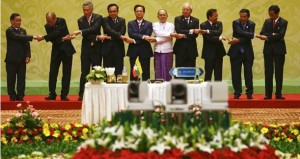WIlliam Boot writes: The Asean goal of creating a single business market among the regional grouping’s 10 member countries is unlikely to happen for some years and certainly not by the target start date of the end of this year.
Burma is one of several countries in the bloc that lacks sufficient infrastructure to benefit from the planned beginning of the Asean Economic Community (AEC), they say.
And the dream of a single, joined-up market with unrestricted movement of labor—similar to the European Union—will be dogged by national self-interest for years to come, it is predicted.
Burma, Cambodia, Laos and Vietnam will be slower to achieve their targets for trade liberalization than the other more affluent members, said the Wharton business school at the University of Pennsylvania in an assessment on the AEC this month.
The other six Asean members are Brunei, Indonesia, Malaysia, the Philippines, Singapore and Thailand.
Meanwhile, the AEC countries are already facing their first and unexpected economic hurdle, Wharton said: sharply falling crude oil prices.
Most Asean countries will be unable to comply with AEC objectives for more relaxed rules on foreign ownership and freer movement of workers by the end of this year due to domestic political constraints, international law firm Allen & Overy said in its latest quarterly report on business.
One of Burma’s leading businessmen, Serge Pun, spoke on the AEC at the annual World Economic Forum in Davos. Protectionist impulses were strong in government and business, but there now seemed to be a determined effort to make the AEC work, he said.
The disparity in development between the 10 member states could be an advantage to an emerging economy such as Burma, which “would welcome the unskilled jobs that more developed Asean members are shedding,” Serge Pun said.
Thailand’s deputy prime minister, Pridiyathorn Devakula, defied the general opinion at Davos: “Some in the audience may not believe it, but believe me, we will have a single market by the end of the year,” he said.
Murray Hiebert, the deputy director of the Sumitro chair for Southeast Asia studies at the Center for Strategic and International Studies (CSIS) in Washington, told the Wharton study that the liberalization of financial services and freer movement of capital and labor would be slow to develop.
“Some Asean countries are anxious about opening up financial services and capital markets out of fear of financial contagion and exchange rate volatility, even though integration would provide opportunities for risk-sharing,” Hiebert said.
A more unified market will eventually lead to a more organized industrial division of labor, some analysts believe. Not all member countries could afford to develop or sustain a car-building industry, for example.
At present Thailand is “Asean’s Detroit.” But Indonesia is fast catching up in production volume, which leaves little room for emerging players such as Burma to attract major investment in vehicle construction.
Commercial nationalism looks likely to impede full open markets for some time.
Burma poses two potential problems for the AEC. Uncertainty following parliamentary elections later this year, and the prospect of more violence between majority Buddhists and the country’s minority Muslim Rohingya population.
In the longer term, the AEC is likely to bring greater cohesion between the member states, but this is likely to be a long and arduous process.
What Asean needs more than anything is a powerful supranational body, something akin to the Commission in the European Union, which could compel its disparate and self-interested members to comply with their promises.

